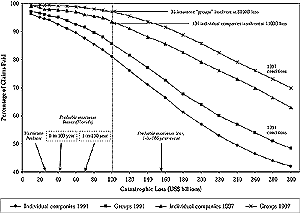|
Continued from previous page
Changes in the magnitude and frequency of extreme events such as hurricanes,
avalanches, fires, and floods have considerable implications for tourism and
recreation. One likely consequence of global climate change is sea-level rise.
This may have considerable consequences for the provision of recreational opportunities
in coastal communities, particularly if it is associated with increased storm
frequency.
|

Figure 15-8: Reductions in claims payable, by size of loss. Ability
of U.S. property-casualty insurance sector, as a whole, to pay claims
over a wide range of losses. The chart shows four views, encompassing
changes in capacity between 1991 and 1997 and whether companies have access
to resources of groups that own them. Groups are not obligated to pay
losses experienced by individual member firms but retain the option to
do so. Together, these four scenarios represent a range of ability to
pay losses. For example, for a US$155 billion loss year—a recent
estimate of probable maximum loss (PML) (GAO, 2000) could be several events
combined, including weather- and nonweather-related ones—65 to 90%
of claims would be paid (adapted from Cummins et al., 1999). PML benchmarks
are from GAO (2000).
|
Coastal zones are among the most highly valued recreational
areas and are primary tourist destinations. Houston (1996) estimates that 85%
of all tourist revenues in the United States are earned by coastal states, and
there are as many as 180 million recreational visitors to U.S. coasts every
year (Boesch et al., 2000). Sea-level rise in beach areas backed by seawalls
or other development that precludes landward migration would lead to loss of
beach area through inundation or erosion and pose an increased threat to the
recreation infrastructure concentrated along the coast (sea-front resorts, marinas,
piers, etc.). Beach nourishment is widely used to protect highly valued recreational
beaches. One study estimates that this adaptation strategy would cost US$14-21
billion to preserve major U.S. recreational beaches from a 50-cm sea-level rise
(Wall, 1998c). Furthermore, impacts to ecologically important wetlands and coral
reefs also could have major implications for sport fishing and diving-related
tourism activities in coastal regions. The risk to coastal recreation is most
prominent in warm-weather destinations in the southern United States and small
island nations in the Caribbean (see Chapter 17 and Section
15.3.2.10), where tourism is a leading sector of the economy.
Intersectoral resource competition also may become more pronounced, particularly
with respect to water resources. Climate change scenarios for the Trent-Severn
Waterway (Walker, 1996) indicate that regulation of flows for adequate downstream
municipal demand would diminish the recreational boating industry, with attendant
impacts for riparian recreational home property values. Increased municipal
and agricultural water demand in arid regions may outweigh development of new
golf courses and, in severe cases, diminish the capacity to irrigate existing
facilities economically. Like declining resource availability and quality, increased
resource competition may constrain the opportunities afforded by a longer recreational
season.
Two main groups can be considered with respect to the potential to adapt to
climate change: participants themselves and businesses and communities that
cater to them. The former may be able to adapt to climate change much more readily
than the latter, which are more likely to have large amounts of capital invested
in fixed locations. The effect of and potential for substitution as an adaptive
strategy, including locations (beach, ski resort), preferred species (coldwater
vs. warmwater fish), and recreational activities broadly (skiing to mountain
hiking, snowmobile to all-terrain vehicle use, golf to sailing) require more
detailed investigation.
Tourism and recreation are not regarded as major net generators of greenhouse
gases (except, perhaps, in the travel phase), but GHG reduction policies (e.g.,
carbon taxes) may increase the cost of travel, with substantial implications
for destination areas (particularly isolated destinations with little domestic
tourism demand).
Improvement in climate change projections, although helpful, will be insufficient
to improve understanding of the implications of climate change for tourism and
recreation. Even if climate change could be reliably forecast now, it is doubtful
if the industry has sufficient understanding of its sensitivity to climatic
variability to plan rationally for future conditions. Furthermore, the salience
of climate change versus other long-term influencing variables in this sector
(globalization and economic fluctuations, fuel prices, aging populations in
industrialized countries, increasing travel safety and health concerns, increased
environmental and cultural awareness, advances in information and transportation
technology, environmental limitations—water supply and pollution) remains
a critical source of uncertainty.
Global climate change will present challenges and opportunities for recreational
industries and destination areas. The net economic impact of altered competitive
relationships within the tourism and recreation sector is highly uncertain.
Studies by Mendelsohn and Markowski (1999) and Loomis and Crespi (1999) attempt
to put an economic value on climate change impacts in the United States. Although
these were pioneering efforts, the assumptions and methods employed limit the
confidence that can be placed in the findings. Until systematic national-level
analyses of economically important recreation industries and integrated sectoral
assessments for major tourism regions have been completed, there will be insufficient
confidence in the magnitude of potential economic impacts to report a range
(based on disparate climate, social, technical, and economic assumptions) of
possible implications for this sector.
|